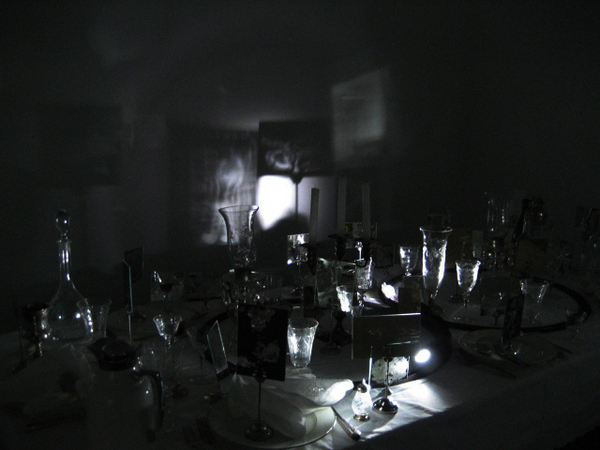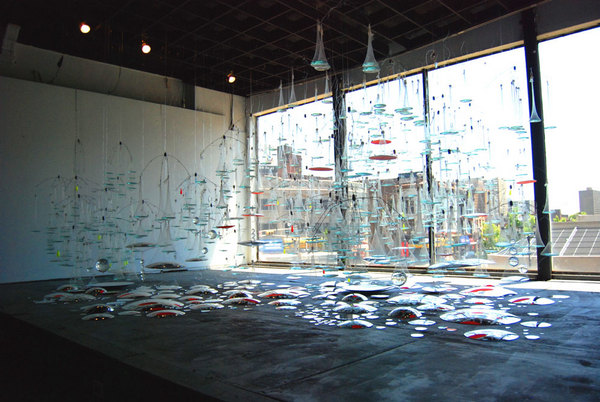This is an archive of the ArtCat Zine, 2007-2009. Please visit our new project, IDIOM.
Recently by Patti Jordan
The Shadows Cast by Ordinary Objects
Hanna von Goeler
Sloan Fine Art - 128 Rivington Street, New York NY
7 January – 7 February 2009
In Hanna von Goeler’s multimedia installation The Shadows Cast By Ordinary Objects, the spectator is invited to the aftermath of a formal meal, complete with strewn silverware and crumpled cloth napkins. Immediate references are made to the medium of film as a toy train weaves a figure “8” amidst the table setting, projecting light and illuminating delicately rendered images etched into tiny mirrors amidst the table's clutter. The blending of the projected images’ meanwhile is created by cast shadows from the toy train, simultaneously linking notions of past, present and future. The work is not a film; it reads instead as a still life that inscribes its own silent, internal motion, conflating the two genres.
Von Goeler’s reflective tableau makes subtle inferences, particularly evident in the miniature etchings and the moving train, to WWII Germany and the holocaust, as well as to Goebbel’s Chamber of Film and National Socialism’s propaganda apparatus. The diverse renderings are comprised of images of skulls, warplanes, concentration camps, German storybook illustrations and other motifs relating to both the nation’s past and present. The meal serves as a meeting place – where we bring our personal and domestic histories to the table. The aspect of relation is emphasized in this environment through images that indirectly project and then bounce off other adjacent images, augmenting their interaction.
There is a combined pleasure and frustration in watching the installation project images for short periods of time – one receives a textured picture, a blur. The heirloom glassware heightens these cast illusions by distorting light to a quasi-fluid state. Light begins to function like a wet brushstroke activating a relationship between the mirrored imagery and the various mediating surfaces on which they land, thereby seeming to transport the still life into a state of animation. The formal aspect of the light has an ethereal, smoky quality to it and allows an element of abstraction to also float elegantly in and out of the space. In contrast, we receive relief from the frustration of the elusive image by being able to fully enjoy the materiality of the small, detailed etchings on the table at our leisure. The crisp clarity in both form and line in these mirrors provides a strong juxtaposition to what the viewer can otherwise not see so clearly. At this last moment of reflection, having digested the work in its entirety, one is able to step away from the table.
Surfactant - A Group Survey
Rupert Ravens Contemporary
85 Market Street, Second Floor, Newark, NJ
In Surfactant, as 17 artists chart immanent relationships amidst a stratum of novel material, surface tension waxes and wanes (a surfactant is a substance that reduces the surface tension of a liquid in which it is dissolved). In the midst of mining obfuscated properties embedded in the art terrain, the viewer is propelled into an intensive dialogue with the historical and metaphorical qualities of each of these works. Capped eloquently by Charles Baudelaire’s “On the Heroism of Modern Life” from Salon of 1846, “Absolute and eternal beauty does not exist, or rather it is only an abstraction creamed from the general surface,” therein divulging inner layers of the objects and installations presented.
With her triad of Asian-styled cylindrical structures, Gae Savannah takes on superficial fashion and “life of Girl.” These towering columns, housed in over-the-top fabric, embody the element of surprise. Topped with pagoda-like peaks, Savannah’s gangling tourelles contain tiny enclosures mimicking mini-boudoirs whose seduction is ultimately subverted by their reduced scale and inaccessibility. In Lu Shia, a plastic shower curtain wraps around its conical understructure while abbreviated details, such as a piece of lavish, quasi-fluorescent fabric, drape and tuck around an interior space like shining satin found in draperies in an Old Master painting, gone “Girl.” With combined references to the oriental and occidental, the ritualistic wrapping of fabric functions both inside and outside the structures, layering the work with cultural and metaphorical meaning. Not content to arouse the viewer with mere self-referentiality, these three regal beauties, in all their gleaming glitterati, strike a pose on a fictitious pop culture runway.
ZINE
HOME
TIPS / COMMENTS
CATEGORIES
CONTRIBUTORS
- Greg Afinogenov
- B. Blagojevic
- Adda Birnir
- Susannah Edelbaum
- Julie Fishkin
- Paddy Johnson
- Jessica Loudis
- Christopher Reiger
- Andrew Robinson
- Peter J. Russo
- Blythe Sheldon
- S.C.Squibb
- Hrag Vartanian


